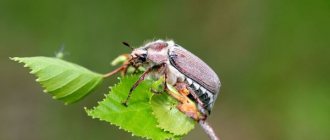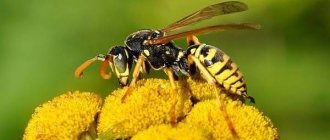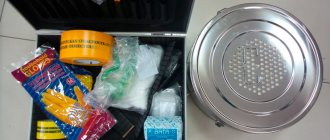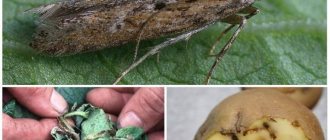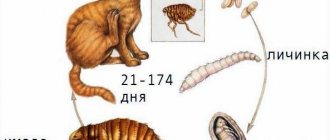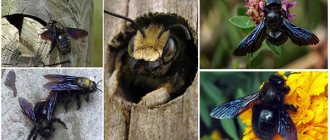- Wild animals
- >>
- Insects
The Colorado potato beetle (Leptinotarsa decemlineata) is an insect belonging to the order Coleoptera and the family of leaf beetles, belongs to the genus Leptinotarsa and is its only representative.
As it turned out, the homeland of this insect is the northeast of Mexico, from where it gradually penetrated into neighboring territories, including the United States, where it quickly adapted to climatic conditions. Over the course of a century and a half, the Colorado potato beetle has spread literally throughout the world and has become the scourge of all potato growers.
Origin of the species and description
Photo: Colorado potato beetle
The Colorado potato beetle was first discovered and described in detail by American entomologist Thomas Sayem. This happened back in 1824. The scientist collected several specimens of a beetle hitherto unknown to science in the southwestern United States.
The name “Colorado beetle” appeared later - in 1859, when an invasion of these insects destroyed entire potato fields in Colorado (USA). After a couple of decades, there were so many beetles in this state that most local farmers were forced to give up growing potatoes, despite the fact that their price had increased significantly.
Video: Colorado potato beetle
Gradually, year after year, in the holds of sea ships that were loaded with potato tubers, the beetle crossed the Atlantic Ocean and ended up in Europe. In 1876 it was discovered in Leipzig, and another 30 years later, the Colorado potato beetle could be found throughout Western Europe except Great Britain.
Until 1918, the breeding grounds of the Colorado potato beetle could be successfully destroyed, until it managed to settle in France (Bordeaux region). Apparently the climate of Bordeaux was ideal for the pest, as it began to rapidly multiply there and literally spread throughout Western Europe and beyond.
Interesting fact: Due to the peculiarities of its structure, the Colorado potato beetle cannot drown in water, so even large bodies of water are not a serious obstacle for it in its search for food.
The beetle allegedly entered the territory of the USSR in 1940, and after another 15 years it was already found everywhere in the western part of the Ukrainian SSR (Ukraine) and the BSSR (Belarus). In 1975, the Colorado potato beetle reached the Urals. The reason for this was a long, abnormal drought, due to which livestock feed (hay, straw) was brought to the Urals from Ukraine. Apparently, a pest beetle also came here along with the straw.
It turns out that in the USSR and other countries of the socialist camp, the mass spread of the beetle coincided with the beginning of the so-called “Cold War”, so accusations of an unexpected disaster were addressed to the American intelligence service CIA. Polish and German newspapers even at that time wrote that the beetle was deliberately thrown into the territory of the GDR and Poland by American aircraft.
Potato pests - garden moth
As soon as white cobwebs appear on the potato leaves, you need to sound the alarm - the plant is damaged by garden moths.
Description
The potato moth is a small, inconspicuous butterfly with a wingspan of 1.5-2 cm. Its brown-gray color makes it invisible on the surface of plants. And the nature of the damage caused to vegetables has firmly established its nickname as the main vegetable leaf-eater.
The larvae reach 1.5 cm in length and are yellow-pink or pale green in color with a dark stripe on the back. Potato moth butterflies lay 1-2 eggs on the inside of leaves.
Nature of plant damage
A couple of weeks after laying, a caterpillar appears and builds sticky webs on the surface of the leaves. Hiding under them, the larva gnaws winding paths in the stems and fruits of the plant. As a result, wounds – “eyes” – appear across the entire surface of the tuber. The moth eats passages through the entire tuber. The inside of these holes is filled with cobwebs and excrement.
Potato pests: garden moth and ways to combat it
A good prevention of moths is deep (about 10 cm) planting of potatoes. Pests do not penetrate to a depth of more than 6-8 cm. The insect dies at temperatures below 5°C, so harvested potatoes should be stored in cool cellars to avoid infection.
Appearance and features
Photo: Colorado potato beetle in nature
The Colorado potato beetle is a fairly large insect. Adults can grow up to 8 - 12 mm in length and approximately 7 mm in width. The body shape of the beetles is somewhat reminiscent of a water drop: oblong, flat at the bottom and convex at the top. An adult beetle can weigh 140-160 mg.
The surface of the beetle's body is hard and slightly shiny. In this case, the back is yellowish-black with black longitudinal stripes, and the belly is light orange. The beetle's black oblong eyes are located on the sides of its round and wide head. On the head of the beetle there is a black spot similar to a triangle, as well as movable, articulated antennae, consisting of 11 parts.
The hard and fairly durable elytra of the potato beetle fit tightly to the body and usually have a yellowish-orange, less often yellow, color, with longitudinal stripes. The wings of the Colorado potato beetle are membranous, well developed, and very strong, which allows the beetle to travel long distances in search of sources of food. Female beetles are usually slightly smaller than males and do not differ from them in any other way in appearance.
Interesting fact: Colorado potato beetles can fly quite quickly - at a speed of about 8 km per hour, and can also rise to great heights.
Resistant varieties
Potatoes that would not be interesting to the Colorado potato beetle do not exist in nature, but breeders have managed to develop several varieties with dense, coarse foliage and a sharp, repellent odor. Due to this, the insect does not like them very much. If the beetle has a choice, it will make it in favor of other, more attractive varieties. That is why many potato growers prefer to grow potatoes such as Lasunok, Temp, Zarevo, Kamensky, Nikulinsky or Utro Previously. These hybrids are highly resistant to the pest. Even a massive invasion of striped fish into fields and vegetable gardens has virtually no effect on their productivity.
Where does the Colorado potato beetle live?
Photo: Colorado potato beetle in Russia
Entomologists believe that the average lifespan of the Colorado potato beetle is approximately one year. At the same time, some more hardy individuals can easily endure winter and even more than one. How do they do it? It’s very simple - they go into diapause (hibernation), so for such specimens, even three years of age is not the limit.
In the warm season, insects live on the surface of the ground or on the plants they feed on. Colorado beetles wait out autumn and winter, burrowing up to half a meter into the soil, and calmly tolerate freezing there down to minus 10 degrees. When spring comes and the soil warms up well - above plus 13 degrees, the beetles crawl out of the ground and immediately begin to look for food and a mate for procreation. This process is not too massive and usually lasts for 2-2.5 months, which greatly complicates the fight against the pest.
Despite the fact that the habitat of the Colorado potato beetle has increased almost several thousand times over the course of a century and a half, there are several countries in the world where this pest has never been seen and has no idea how dangerous it is. There are no Colorados in Sweden and Denmark, Ireland and Norway, Morocco, Tunisia, Israel, Algeria, and Japan.
Now you know where the Colorado potato beetle came from. Let's see what he eats.
How to fight?
So how to get rid of Colorado potato beetle larvae? In the fight against Colorado potato beetle larvae, it is better to give preference to traditional methods. A huge number of poisons and chemicals have been invented, but we should not forget that in the future the fruits of the plant will end up on the dinner table along with the poison that got into them.
The most effective and ancient way to combat Colorado potato beetle larvae is their mechanical collection and destruction. All larvae should be collected in a jar with a strong salt solution.
They should never be crushed between rows of plants; the larva may survive and begin to eat the crop again. By regularly inspecting the plantation, you can save your work (if the field is not too large). On large plantations this method is completely ineffective.
Another long-standing method of combating Colorado potato beetle larvae is pollination with ash. When pollinating, it is better to give preference to birch ash; it copes better with larvae.
The procedure should be carried out in the morning, when there are still drops of dew on the leaves. Approximately 10 kg of ash is consumed per 1 hectare of land; even with this ratio, within a couple of days the larvae of the Colorado potato beetle will die, just like the adults. The procedure of pollination with ash can be carried out once every 2 weeks. After the plant blooms, it should be dusted once a month.
Instead of ash, you can also use cornmeal, which swells in the stomach of the larva and kills it, as well as plaster or dry cement. It will be useful to sprinkle fresh sawdust between the rows of plants. Colorado beetles are very sensitive to the smell of wood; they will avoid the field and will not lay eggs.
Also, to prevent the appearance of eggs and larvae, potatoes should be hilled high. Other garden pests – ants – will also help in the fight. The Colorado potato beetle cannot stand proximity to these insects.
You can plant plants near the field whose smell the beetle simply cannot stand:
- Marigold;
- Marigolds (calendula);
- Nasturtium;
- Night violet;
- Coriander;
- Legumes;
- Onion.
We talked in more detail about how to deal with the Colorado potato beetle in a separate article.
What does the Colorado potato beetle eat?
Photo: Colorado potato beetle on a leaf
The main food of Colorado beetles, as well as their larvae, are young shoots and leaves of plants of the nightshade family. Beetles will find food wherever potatoes, tomatoes, tobacco, eggplants, petunias, sweet peppers, and physalis grow. They do not disdain wild plants of this family.
At the same time, beetles like to eat potatoes and eggplants most of all. Insects can eat these plants almost completely: leaves, stems, tubers, fruits. In search of food, they are able to fly very far, even tens of kilometers. Despite the fact that insects are very voracious, they can easily endure forced hunger for up to 1.5-2 months, simply falling into short-term hibernation.
Due to the fact that the Colorado potato beetle feeds on the green mass of plants of the nightshade family, a toxic substance, solanine, constantly accumulates in its body. Because of this, the beetle has very few natural enemies, since the beetle is simply inedible and even poisonous.
Interesting fact: Curiously, the greatest harm to plants is caused not by adult Colorado potato beetles, but by their larvae (stages 3 and 4), since they are the most voracious and are capable of destroying entire fields in a few days under favorable weather conditions.
Potato moth
Description
The potato moth is a dirty gray moth with dark spots along the rear edges of its wings. And the damage is caused by the yellowish-pink or gray-green caterpillars of these butterflies. More often they invade the leaves, but do not disdain both stems and tubers.
At the beginning of spring, there are few larvae; they feed on young and succulent seedlings, and later move on to stems and leaves. The peculiarity of this pest is that it spoils potatoes after harvesting - during the storage period of the vegetable.
Control measures
Successful fight against potato moth will be crowned with success if the following conditions are met:
- For planting, take proven seed material. Potential larvae can be destroyed by heating the tubers at a temperature of 40 °C for several hours;
- constantly monitor potato planting and storage conditions;
- when sowing, maintain a planting depth of at least 15 cm;
- hill up bushes repeatedly;
- carry out deep tillage before winter;
- actively fight weeds;
- Before storing potatoes, treat them with a solution of methyl bromide.
To destroy butterflies and caterpillars, biochemical insecticides are used: Bitoxibacillin, Entobacterin, Dendrobacillin, Lepidocide. They are used to treat bushes before the ovaries appear, thereby reducing the fertility of females and delaying the development of the moths themselves.
Features of character and lifestyle
Photo: Colorado potato beetle
The Colorado potato beetle is very prolific, voracious and can quickly adapt to various environmental factors, be it heat or cold. The pest usually survives unfavorable conditions by hibernating for a short time, and can do this at any time of the year.
The young Colorado potato beetle (not the larva) is bright orange in color and has a very soft outer covering. Within 3-4 hours after birth from the pupa, the beetles take on a familiar appearance. The insect immediately begins to feed intensively, eating leaves and shoots, and after 3-4 weeks reaches sexual maturity. Colorado potato beetles that were born in August or later usually hibernate without offspring, but most of them will make up for this loss the following summer.
One of the features unique to this type of beetle is the ability to go into long-term hibernation (diapause), which can last 3 years or even longer. Although the pest flies beautifully, which is facilitated by strong, well-developed wings, in moments of danger for some reason it does not do this, but pretends to be dead, tucking its paws to its abdomen and falling to the ground. Therefore, the enemy has no choice but to simply leave. Meanwhile, the beetle “comes to life” and continues to go about its business.
Potatoes are harmful, humans are benefited
Colorado potato beetles are a real scourge for farmers and gardeners. It multiplies so quickly and eats so much that in 1-2 weeks you can completely lose your harvest of potatoes, tomatoes and eggplants. Colorado beetles eat the greens of these plants with great appetite and great speed.
However, there is little benefit from Colorado beetles; observant people have noticed that a medicine can be prepared from the larvae and adults of the Colorado potato beetle, which is mainly used externally.
The fact is that the tissues of the larvae and adults of the Colorado potato beetle contain large quantities of solanine, which the beetles obtain from the leaves and stems of potatoes. Solanine is a glycoalkoloid, a toxic substance with healing properties.
Gardeners and summer residents have found that if you crush the Colorado potato beetle larvae and smear the warts with the resulting pulp, they will disappear within 3-4 days. Corns and spurs on the soles are treated in a similar way.
Recipe 1.
For cracked heels and calluses, you need to prepare the following remedy: 300 grams of corn leaves should be poured with three liters of water and boiled until half of the liquid has evaporated. Then you need to add 100 grams of celandine and crushed Colorado potato beetles to the hot broth. Remove from heat and leave for 15-20 minutes. You need to steam your feet in the hot broth, adding hot water as needed. You need to do 5-6 such procedures every day, as a result, the cracks in the heels will heal, the corns will soften and fall off, and the pain will stop.
Recipe 2.
A recipe for those who are not squeamish, if your facial skin is irritated, you need to make a mask from the liquid of crushed Colorado potato beetles for 30 minutes, then rinse off the mask with banana water. Banana water is prepared according to this recipe: pour 100 grams of banana peel into 500 ml of boiling water and let it brew. After 3-4 procedures, the face will become smooth and clean.
Recipe 3.
Colorado beetles against baldness. Mash 4 beetles and 4 beetle larvae and mix with an equal amount of onion pulp. Rub the mixture into areas of hair loss at night. In the morning, wash off the mask with shampoo. To achieve the desired result, you need to do 6 such procedures, then 1 night break and another 6 procedures at night.
Recipe 4.
Alcohol tincture of the Colorado potato beetle. Collect 1/3 of a half-liter jar of Colorado beetles along with larvae, fill with alcohol or purified vodka. Place the jar in a dark place for 2 weeks. Then strain, use the tincture to treat baldness in a mixture with chopped onion and garlic. The same tincture can be used for rubbing against radiculitis, rheumatism and gout.
Social structure and reproduction
Photo: Colorado beetles
As such, Colorado beetles, unlike other types of insects (ants, bees, termites), do not have a social structure, since they are solitary insects, that is, each individual lives and survives on its own, and not in groups. When it becomes warm enough in the spring, beetles that have successfully overwintered crawl out of the ground and, having barely gained strength, the males begin to look for females and immediately begin mating. After the so-called “mating games,” fertilized females lay eggs on the underside of the leaves of the plants on which they feed.
One adult female, depending on the weather and climate of the area, is capable of laying approximately 500-1000 eggs during the summer season. Colorado eggs are usually orange, 1.8 mm in size, oblong-oval, located in groups of 20-50 pieces. On days 17-18, the eggs hatch into larvae, which are known for their gluttony.
Stages of development of Colorado potato beetle larvae:
- in the first stage of development, the larva of the Colorado potato beetle is dark gray in color with a body up to 2.5 mm long and small thin hairs on it. It feeds exclusively on tender young leaves, eating away their pulp from below;
- at the second stage, the larvae are already red in color and can reach sizes of 4-4.5 mm. They can eat the entire leaf, leaving only one central vein;
- in the third stage, the larvae change color to red-yellow and increase in length to 7-9 mm. There are no longer any hairs on the surface of the body of individuals of the third stage;
- at the fourth stage of development, the beetle larva changes color again - now to yellowish-orange and grows to 16 mm. Starting from the third stage, the larvae are able to crawl from plant to plant, eating not only the pulp of the leaves, but also young shoots, which causes great harm to the plants, slowing down their development and depriving farmers of the expected harvest.
All four stages of development of the Colorado potato beetle larva last approximately 3 weeks, after which it turns into a pupa. “Adult” larvae crawl into the soil to a depth of 10 cm, where they pupate. The pupa is usually pink or orange-yellow. The duration of the pupal phase depends on the weather. If it’s warm outside, then after 15-20 days, it turns into an adult insect that crawls to the surface. If it’s cool, this process can slow down 2-3 times.
Potato protection system with drugs
- The drugs are used separately and in a tank mixture. When used together, they significantly increase their effectiveness.
- Potatoes are processed once during the growing season of the crop.
- In exceptional cases, both drugs can be used during the growing season. Repeated treatment is carried out no earlier than 45 days from the date of the first spraying and no less than a month before harvesting.
- The optimal period of spraying is the budding phase - the beginning of flowering or after the end of flowering of the crop.
- Spraying is best done early in the morning or in the evening in dry, windless weather.
- When spraying with a fine sprayer, it is necessary to thoroughly wet the treated crops.
The plant protection system by treating with ready-made tank mixtures allows:
- reduce the number of treatments and chemical load on plants by using one-time spraying,
- use a professionally prepared tank mixture, which will reduce damage to plants due to incorrectly or poorly prepared working solutions,
- reduce the cost of money and time for purchasing the necessary preparations, their preparation and processing of plants.
Natural enemies of Colorado potato beetles
Photo: Colorado potato beetle
The main enemies of the Colorado potato beetle are the Perillus bioculatus and Podisus maculiventris bugs. Adult bedbugs, as well as their larvae, eat the eggs of Colorado potato beetles. Also, a significant contribution to the fight against the pest is made by dorifophagous flies, which have become accustomed to laying their larvae in the body of the Colorado potato.
Unfortunately, these flies prefer a very warm and mild climate, so they do not live in the harsh conditions of Europe and Asia. Also, familiar local insects feed on the eggs and young larvae of the Colorado potato beetle: ground beetles, ladybugs, lacewing beetles.
It is worth noting that many scientists believe that the future in the fight against pests of cultivated plants, including Colorado potato beetles, does not lie with chemicals, but with their natural enemies, since this method is natural and does not cause severe harm to the environment.
Some farms specializing in growing environmentally friendly products use turkeys and guinea fowl to combat the Colorado potato beetle. These poultry love to eat both adults and their larvae, since this is a feature of the species, and they are accustomed to such food almost from the first days of life.
Who eats the pest
There is no need to rely on birds that live in the wild with a tropical climate. Therefore, scientists turned their attention to domestic animals.
The pest's enemies turned out to be domestic birds:
- chickens;
- partridges;
- guinea fowl;
- turkeys;
- pheasants.
Important! In order for the bird to get used to using the Colorado potato beetle as food, it is mixed in crushed form into the food of the chicks.
Chicken
It does not feed on adult pests or larvae on its own. This is due to the fact that the natural habitat of domestic hens is Asia, not America. This insect does not belong to the usual food. Therefore, chickens have to be trained.
Young birds at 3-4 months are taught to eat these insects by mixing larvae into the food. After some time, the birds get used to seeing the pest as food. Once trained chickens are released into the garden beds, they find food for themselves, clearing the plantings of pests and other insects along the way.
Partridges
Poultry lovers keep gray partridges on their farm. These unpretentious creatures thrive in cages on good food. They can also feast on pest larvae. But releasing wild birds into the garden to fight insects is hardly advisable. They will peck the Colorados, but it is unlikely that they will be able to drive them back into the enclosures.
Turkeys and guinea fowl
The Colorado potato beetle is afraid of poultry, which is found in peasant farmsteads in Mexico. Turkeys and guinea fowl are ardent opponents of the pest. Released into vegetable gardens that have not been treated with chemicals, the birds happily peck at the soft larvae. Adults are not abandoned either.
However, they also need to be “trained” to destroy the pest. From three weeks of age, chickens are given grated potatoes and green tops in their complementary food. They gradually become accustomed to the smell of the vegetable and develop the habit of looking for food with a similar aroma. After 2 weeks, crushed Colorado potato beetles are thrown into the mash. Three-month-old turkey chicks and guinea fowl are sent to free range in the garden. Before this, they are not fed for a day so that they eat pests more intensively.
Guinea fowl or Guinea chickens are rare guests in the poultry yard in Russia. Despite their unpretentiousness, tasty meat and eggs, they still remain exotic in private backyards. This bird itself pecks soft-bodied larvae and adults without raking the soil in potato plantings. The guinea fowl can even eat clutches of eggs from the tops without harming the green leaves.
Turkeys require more careful attention. The Indian rooster has a complex temperament, he needs a special approach and good food, he often gets sick and may refuse to feed. But the bird’s stomach is adapted to eating the Colorado potato beetle and larvae. Turkey poults are taught from childhood to collect them as food.
Prevention measures
Weeds are one of the favorite habitats of leaf beetles. It is necessary to deprive the pest of this source of food.
They get rid of excess vegetation in the garden and in the garden, and in the fall the leaves around the trees are collected and burned. Dried branches and faded flower stalks are cut off and destroyed.
The soil is deeply loosened both in the beds and between the rows to destroy the pest pupae. In the fall it is dug up in the garden and in tree trunks, and in the spring it is harrowed.
Unfortunately, leaf beetles are often noticed late on a site, when traces of their activity are already evident. The task of every gardener is to identify pests in time, and getting rid of them is a simple matter.
You will learn more about leaf beetles from the video.
Preparation of tank mixture solution
- For 10 liters of solution use 1 powder (10.6 g),
- the powder is dissolved in 1 liter of clean water at room temperature,
- The mother solution is thoroughly mixed (at least 5 minutes) until completely dissolved,
- add 9 liters of water to the container and stir again,
- the resulting working solution is poured into a fine sprayer,
- residues are disposed of on the same day in specially designated areas away from water sources and sewerage facilities.
Distinctive features of the drugs “Commander” and “Iskra Triple Effect”
“Commander” contains a substance that kills pests within 2–3 days and retains its protective properties for 2–4 weeks. Recommended for pre-planting treatment of potato tubers and green plants. Plants are treated at the beginning of the growing season, when beetles are just beginning to appear on the plantings after the winter period and their number is limited. If the number of beetles does not exceed the harmfulness threshold, one treatment is sufficient.
“Iskra Triple Effect” is a drug for exterminating the Colorado potato beetle in extreme conditions. Destroys pests within 1-2 hours. Recommended for large infestations of beetles, epiphytotic hatching of larvae, or a weak reaction to another drug used. One-time use is sufficient.
Iskra Triple Effect - set for preparing tank mixture spark + commander maxi


